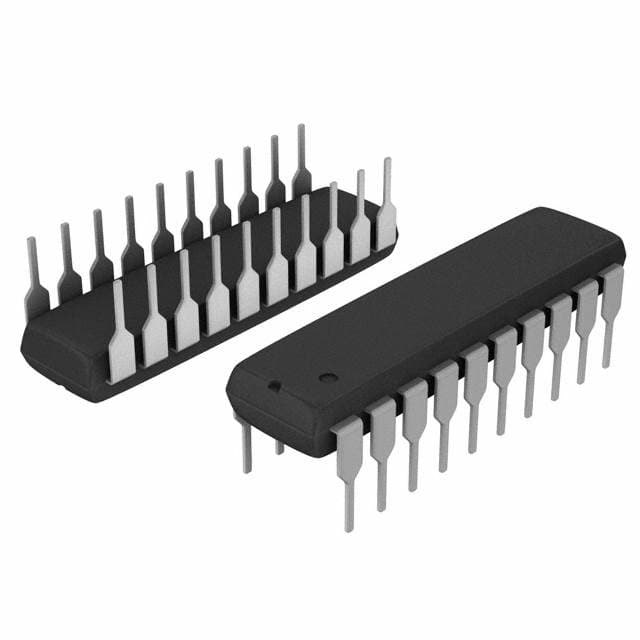Lihat spesifikasi untuk detail produk.

Encyclopedia Entry: 74ACT573PC
Product Information Overview
- Category: Integrated Circuit (IC)
- Use: Data storage and transfer
- Characteristics: High-speed, octal transparent latch with 3-state outputs
- Package: DIP (Dual In-line Package)
- Essence: The 74ACT573PC is a latch that can store and transfer data in electronic circuits.
- Packaging/Quantity: Typically sold in packs of 25 units.
Specifications
- Logic Family: ACT
- Number of Bits: 8
- Latch Type: Transparent
- Output Type: 3-state
- Operating Voltage Range: 4.5V to 5.5V
- Operating Temperature Range: -40°C to +85°C
- Propagation Delay: 6 ns (typical)
- Input Capacitance: 3 pF (typical)
- Output Capacitance: 15 pF (typical)
Detailed Pin Configuration
The 74ACT573PC has a total of 20 pins, which are arranged as follows:
+----+--+----+
OE1 |1 +--+ 20| VCC
LE1 |2 19| D0
D7 |3 18| D1
D6 |4 17| D2
D5 |5 74 16| D3
D4 |6 ACT 15| D4
GND |7 573 14| D5
Q7 |8 13| D6
Q6 |9 12| D7
Q5 |10 11| OE2
+-----------+
Functional Features
- The 74ACT573PC is an octal transparent latch, meaning it can store and transfer data on its eight input pins.
- It features 3-state outputs, allowing multiple devices to share a common bus without interfering with each other's signals.
- The latch is enabled by the LE1 (Latch Enable) pin, which controls the transfer of data from the input pins to the output pins.
- The OE1 (Output Enable) and OE2 pins control the output state, enabling or disabling the 3-state outputs.
Advantages and Disadvantages
Advantages: - High-speed operation makes it suitable for applications requiring fast data transfer. - 3-state outputs allow for efficient bus sharing in multi-device systems. - Wide operating voltage and temperature range provide versatility in various environments.
Disadvantages: - Limited number of bits (8) may not be sufficient for certain applications requiring larger data storage. - DIP package may not be as compact as surface-mount alternatives, limiting space-saving possibilities.
Working Principles
The 74ACT573PC operates based on the principle of transparent latching. When the latch enable (LE1) pin is high, the input data is transferred to the output pins. The output enable (OE1 and OE2) pins control the output state, either enabling the outputs to drive external circuitry or placing them in a high-impedance state.
Detailed Application Field Plans
The 74ACT573PC is commonly used in various digital systems where data storage and transfer are required. Some typical application fields include:
- Microprocessor-based systems
- Data communication equipment
- Industrial automation systems
- Instrumentation and measurement devices
- Automotive electronics
Detailed and Complete Alternative Models
- 74HC573: Similar octal transparent latch with 3-state outputs, but operates at a lower voltage range (2V to 6V).
- 74LS573: Octal transparent latch with 3-state outputs, compatible with TTL logic levels.
- 74F573: High-speed octal transparent latch with 3-state outputs, suitable for applications requiring faster operation.
These alternative models offer similar functionality to the 74ACT573PC but may have different operating characteristics or voltage requirements.
Word count: 530 words
Sebutkan 10 pertanyaan dan jawaban umum terkait penerapan 74ACT573PC dalam solusi teknis
Sure! Here are 10 common questions and answers related to the application of 74ACT573PC in technical solutions:
Q: What is the 74ACT573PC? A: The 74ACT573PC is an octal transparent latch with 3-state outputs, commonly used in digital systems.
Q: What is the purpose of the 74ACT573PC? A: The 74ACT573PC is used to store and control the flow of data in a digital system by latching input signals and providing output signals.
Q: How many bits can the 74ACT573PC handle? A: The 74ACT573PC can handle 8 bits of data, as it is an octal latch.
Q: What is the maximum operating voltage for the 74ACT573PC? A: The 74ACT573PC has a maximum operating voltage of 5.5V.
Q: Can the 74ACT573PC be used in both synchronous and asynchronous applications? A: Yes, the 74ACT573PC can be used in both synchronous and asynchronous applications depending on the design requirements.
Q: What is the typical power consumption of the 74ACT573PC? A: The typical power consumption of the 74ACT573PC is low, making it suitable for power-sensitive applications.
Q: Can the 74ACT573PC drive LEDs or other low-power devices directly? A: Yes, the 74ACT573PC can drive LEDs or other low-power devices directly through its 3-state outputs.
Q: Is the 74ACT573PC compatible with TTL logic levels? A: Yes, the 74ACT573PC is compatible with TTL logic levels, making it easy to interface with other TTL devices.
Q: Can the 74ACT573PC be cascaded to handle more than 8 bits of data? A: Yes, multiple 74ACT573PCs can be cascaded together to handle larger data widths.
Q: What are some common applications of the 74ACT573PC? A: The 74ACT573PC is commonly used in microprocessors, memory systems, and general-purpose digital systems where data storage and control are required.
Please note that these answers are general and may vary depending on specific design considerations and requirements.

